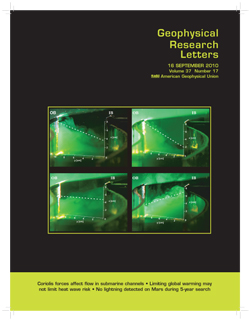Coriolis forces influence the secondary circulation of gravity currents flowing in large-scale sinuous submarine channel systems
Remo Cossu, Mathew G. Wells
A combination of centrifugal and Coriolis forces drive the secondary circulation of turbidity currents in sinuous channels, and hence determine where erosion and deposition of sediment occur. Using laboratory experiments we show that when centrifugal forces dominate, the density interface shows a superelevation at the outside of a channel bend. However when Coriolis forces dominate, the interface is always deflected to the right (in the Northern Hemisphere) for both left and right turning bends. The relative importance of either centrifugal or Coriolis forces can be described in terms of a Rossby number defined as Ro = U/fR, where U is the mean downstream velocity, f the Coriolis parameter and R the radius of curvature of the channel bend. Channels with larger bends at high latitudes have ∣Ro∣ < 1 and are dominated by Coriolis forces, whereas smaller, tighter bends at low latitudes have ∣Ro∣ ≫ 1 and are dominated by centrifugal forces.
Date: 2010-9-16
